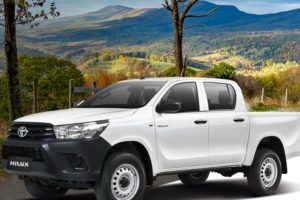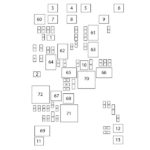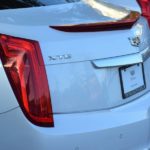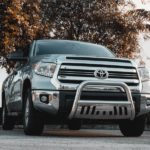Quick Navigation
The Toyota Hilux is a trusty and reliable car, but like all cars, it needs regular maintenance and care.

Knowing the locations of your fuse boxes and understanding the diagrams that explain what each fuse does is an important part of owning a car.
We will provide a detailed overview of the fuse box locations and diagram explanations for the 2004 – 2014 Toyota Hilux.
1. About the 2004-2014 Toyota Hilux
The 2004-2014 Toyota Hilux is a rugged, reliable, and stylish workhorse.
The seventh generation of the legendary pick-up truck was one of the most popular models ever produced by Toyota.
It was praised for its excellent performance, reliability, and off-road capabilities.
The Hilux had impressive features, including a robust chassis, independent suspension, anti-lock brakes, power windows, and cruise control.
It also featured a range of engine options, from a 2.0L four-cylinder petrol engine to a 3.0L V6 turbo diesel option that provided exceptional power and torque output.
The interior of the Hilux was designed with comfort in mind while still keeping practicality at the forefront – air conditioning was available, as were power windows and cruise control.
The dashboard was soft-touch and intuitive, allowing drivers to easily adjust settings such as the radio or heating/cooling systems.
Overall, the 2004-2014 Toyota Hilux is an impressive pick-up truck that can easily take on any task.
Its combination of comfort, practicality, and reliability make it an ideal choice for those looking for a reliable workhorse that won the market.
2. Fuse Box Locations
You first need to know where to find your vehicle’s fuse boxes.
On the 2004 – 2014 Toyota Hilux, two main fuse boxes are located in different areas of the vehicle.
The first one is under the dashboard on the driver’s side, while the second is in the engine bay near the battery.
Each box contains fuses responsible for controlling different components in your car.
If a component stops working, it could be because the fuse has blown and needs to be replaced.
Inside the fuse boxes, you will find the fuses labeled according to their purpose and location in your vehicle.
Differences Between Fuse Boxes on a 2004-2014 Toyota Hilux
The fuse box is located on the driver’s side of your engine compartment, near the battery.
This rectangular-shaped container has a plastic cover with a diagram that displays each fuse and relay’s location, amperage, and purpose.
If you want to locate the cabin fuse box in your vehicle, it’s situated underneath the dashboard on the driver’s side.
The box has a plastic lid containing helpful diagrams about its fuses, relays, and data related to their amperage rating and purpose.
3. Fuse Diagram Explanation
Once you have located your car’s fuse box, you will need to understand what each fuse does to determine if one needs to be replaced.
To help with this, we have provided diagrams that explain how each fuse works on the 2004 – 2014 Toyota Hilux.
The diagram outlines each component associated with a particular fuse and indicates which ones are powered when that specific fuse is turned on.
Additionally, there may also be special fuses that are only turned on when a certain feature is activated.
Passenger Compartment Fuse Box
The passenger compartment fuse box on a 2004 Toyota Hilux is located under the dashboard on the left side of the driver’s footwell.
It contains several fuses and relays that control various electrical components in the vehicle, including the headlights, radio, air conditioning, and power windows.
You can find most of the fuses related to interior electrical devices here, which makes it easy to do rewiring or replace fuses without taking apart the entire dashboard.
The fuse box also houses several important fuses, which control high-current electrical devices like the starter motor and fuel pump.

| No. | Ampere | Function | |
| 1 | INJ | 15 | Fuel injection |
| 2 | OBD | 7,5 | OBD system (used for on-board diagnosis) |
| 3 | STOP | 10 | Used for all stop lights (including both the mounted stoplight as well as the regular ones), traction control, ABS, VSC and shift-lock control |
| 4 | TAIL | 10 | Instrument panel lighting, fuel injection, fog lights (front), tail lights, information display, daytime lights, automatic lights switch |
| 5 | PWR OUT | 15 | Power outlet |
| 6 | ST | 7,5 | Starter, measuring instruments (gauges and meters), fuel injection
|
| 7 | A/C | 10 | AC control |
| 8 | MET | 7,5 | Diesel particle filter, meters and gauges. |
| 9 | CIG | 15 | Cigarette lighter power switch |
| 10 | ACC | 7,5 | Audio system, power outlet, clock, power rearview mirror control system, shift lock control system and multi-information display |
| 11 | IGN | 7,5 | Fuel injection system, SRS airbags and fuel pump |
| 12 | WIP | 20 | Windshield washers and wipers |
| 13 | ECU-IG & GAUGE | 10 | AC system, fuel injection, wireless remote, seat belt reminder for the passenger, AC. rear-differential lock, fuel injection, anti-blocking system, rear window defogger, rear view mirror defogger, turn signal lights control, steering wheel sensor, headlights, daytime lights, TRC, VSC, hazard lights, door courtesy switches, heated seats, cruise control, information display, charging systems. |
Engine Compartment Fuse Box
The Engine Compartment Fuse Box in the Toyota Hilux 2004-2014 is located on the right side of the engine compartment.
The fuse box houses both fuses and relays, which are used to protect components from short circuits or overloading.
This fuse box contains 12 fuse slots that contain various electronic components such as ECUs, ABS controllers, fuel pumps and other electrical systems.
This fuse box also includes several relay sockets that are used to control different functions within the vehicle’s electrical system, such as starting the engine, unlocking doors, and controlling headlights.
Some fuses are shared with the fuse box in the cabin. Keep in mind that only one of them can be burned so you need to check both if an electrical component is not working.

| Fuse | Ampere | Function | |
| 1 | — | 25 | Spare fuse |
| 2 | — | 15 | Spare fuse |
| 3 | — | 10 | Spare fuse |
| 4 | FOG | 7,5 | Europe, Morocco:
From Aug. 2012 – Aug. 2013: Used for fog lights (front) From Aug. 2013: Used for fog lights (front) |
| 15 | Before Aug. 2013: Used for fog lights (front)
Except for Europe, Morocco: From Aug. 2012 – Aug. 2013: Used for fog lights (front) |
||
| 5 | HORN | 10 | Horn |
| 6 | EFI | 25 | Fuel injection system |
| 7 | — | — | — |
| 8 | H-LP RL | 20 | Before Jun. 2011: Right-hand low headlight |
| 15 | From Jun. 2011: Right-hand low headlight | ||
| 9 | H-LP LL | 20 | Before Jun. 2011: Left-hand low headlight |
| 15 | From Jun. 2011: Left-hand low headlight | ||
| 10 | H-LP RH | 20 | Before Jun. 2011: Right-hand high headlight and right-hand low headlight |
| 15 | From Jun. 2011: Right-hand high headlight and right-hand low headlight | ||
| 11 | H-LP LH | 20 | Before Jun. 2011: Left-hand high headlight and left-hand low headlight |
| 15 | From Jun. 2011: Left-hand high headlight and left-hand low headlight | ||
| 12 | EFI NO.2 | 10 | Fuel injection system (both multiport and sequential) |
| 13 | ECU-IG NO.2 | 10 | (both multiport and sequential) |
| 14 | ECU-B | 7,5 | Before Aug. 2008: Wireless remote, door courtesy switches, steering wheel system, headlights, door lock system |
| 10 | From Aug. 2008: Wireless remote, door courtesy switches, steering wheel system, headlights, door lock system | ||
| 15 | RAD | 15 | Before Aug. 2013: Audio |
| 20 | From Aug. 2013: Audio | ||
| 16 | DOME | 7,5 | Light for engine switch, interior lights, meters, clock information display (on-board computer), wireless remote, day, daytime lights, fog lights, personal light (above drive and passenger) |
| 17 | A/F | 20 | Control system for emission levels |
| 18 | ETCS | 10 | Fuel injection system (both multiport and sequential) and electric throttle |
| 19 | ALT-S | 7,5 | Charging system |
| 20 | TURN-HAZ | 15 | Hazard lights and turn signal lights |
| 21 | — | — | — |
| 22 | ECU-B NO.2 | 7,5 | AC |
| 23 | DCC | 30 | “ECU-B”, “DOME” and “RAD” fuses |
| 24 | PTC NO.1 | 50 | Power heater |
| 25 | H-LP CLN | 30 | Before Jun. 2011: Cleaners for headlights |
| PWR SEAT | 30 | Power seat | |
| 26 | PTC NO.2 | 50 | Europe:
From Aug. 2010 – Jun. 2011 (without Automatic A/C): Power heater From Jun. 2011: Power heater |
| 30 | Europe:
Before Jun. 2011 (with Automatic A/C): Power heater Before Aug. 2010 (without Automatic A/C): Power heater Australia: Power heater |
||
| 27 | ABS NO.1 | 40 | Before Aug. 2008: ABS, TRC and VSC |
| H-LP CLN | 40 | From Jun. 2011: Headlight cleaners | |
| 28 | FR HTR | 40 | Before Aug. 2009: Air conditioning system, “A/C” fuse |
| 50 | From Aug. 2009: Air conditioning system, “A/C” fuse | ||
| 29 | ABS NO.2 | 30 | ABS, TRC and VSC |
| 30 | ABS NO.1 | 40 | From Aug. 2008: ABS, TRC and VSC |
| 31 | ALT | 100 | Charging system, “PWR SEAT”, “HLP CLN”, “FR HTR”, “AM1”, “IG1”, “PTC NO.1”, “PTC NO.2”, “PWR OUT”, “STOP”, “TAIL” and “OBD” fuses |
| 32 | GLOW | 80 | Glows (fuel heaters) |
| 33 | BATT P/I | 50 | “FOG”, “HORN” and “EFI” fuses |
| 34 | AM2 | 30 | Starter, “ST”, “IGN”, “INJ” and “MET” fuses |
| 35 | MAIN | 40 | “H-LP RH”, “H-LP LH”, “H-LP RL” and “H-LP LL” fuses |
| 36 | A/PUMP | 50 | Fuel injection system (both multiport and sequential) |
Conclusion
Knowing the locations of your fuse boxes and understanding the diagrams that explain what each fuse does is an essential part of owning a car.
This guide explains where to find the fuse boxes in the 2004 – 2014 Toyota Hilux and diagrams showing how individual fuses are associated with certain components.
Having this information can help you quickly identify which fuse needs to be replaced if one of your vehicle’s features stops working.
Additionally, it will also help you save time and money by not having to replace unnecessary fuses or bring your car into a shop for repairs.
So now that you know more about your vehicle’s fuse box and its diagram explanations, you can take action and keep your Toyota Hilux running smoothly.

James has been a car enthusiast since his childhood when he learned the differences between a ford and a chevy from his father. He loves to drive and restore old cars with a special drive for Italian marvels. Currently, he has a 1968 Alfa Romeo. He has studied aeronautics and civil aviation in his college and still gets smitten by Galant SS and Lancer GSR.
He is a New York-based product training director working with a giant automotive retailer. He loves to review and uncover the vehicles and their fascinating stories. He believes in keeping it legitimate with a keen passion for research on the latest technological upgrades in cars. While reading his articles or blogs, you can sense the extensive research and dedication backing the piece of text. He loves fried chicken, music, and spending quality time with his pet dog.







